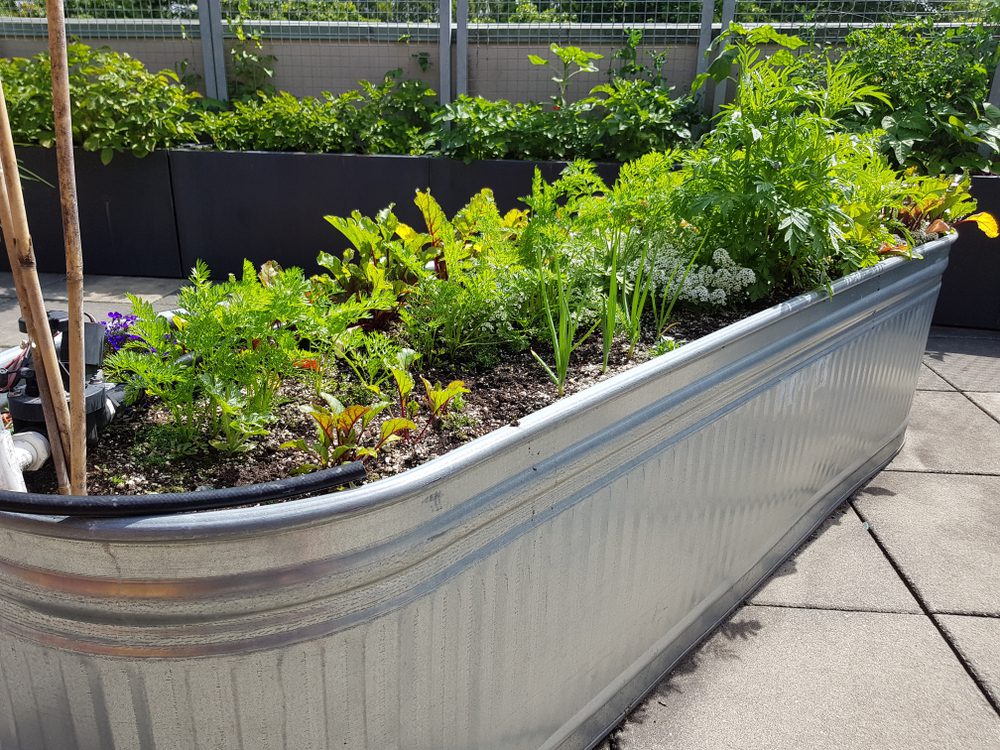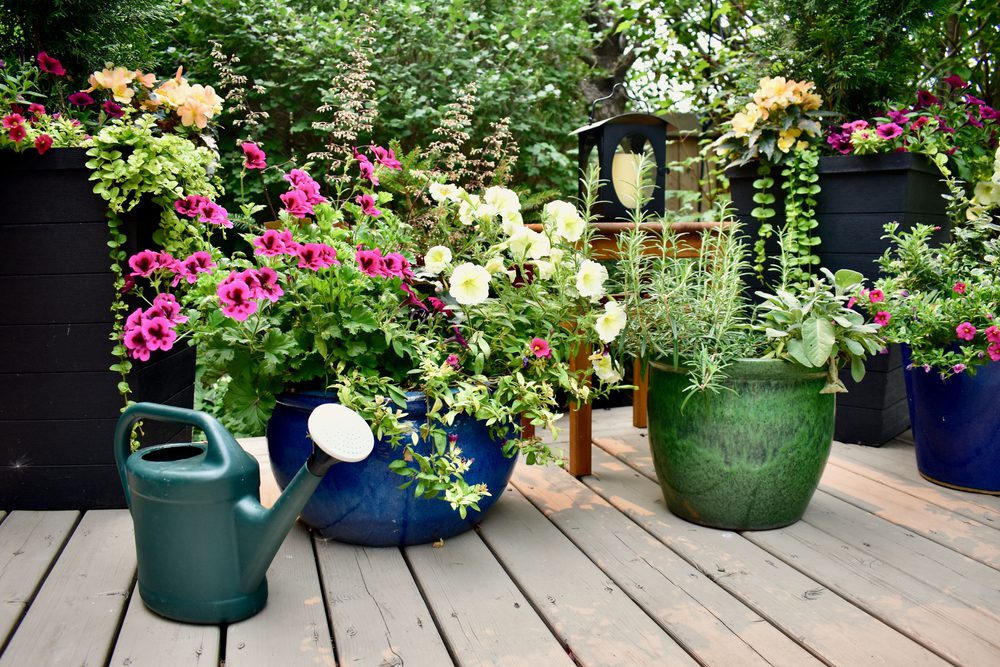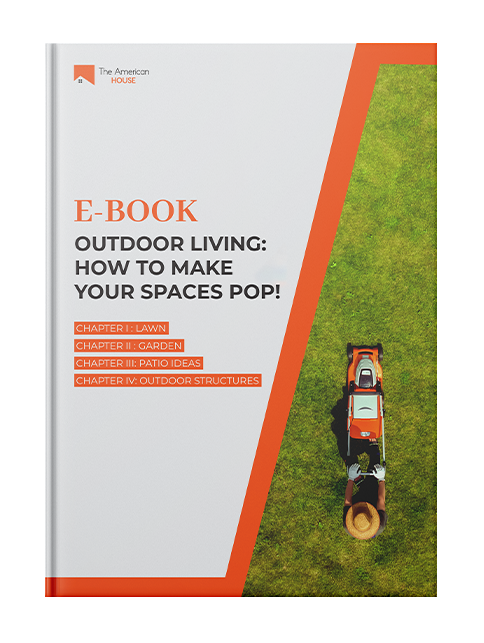Digging a garden can be a daunting task, but what if we told you there are ways to create a veggie or flower garden with minimal digging? Yes, you can make this happen with just a few raised garden bed ideas! All you need when making a raised bed is some creativity, patience, and time. Since it’s a DIY activity, you won’t need any external help. Not only can you do a raised garden bed by yourself, but it’s also a fun activity that’s almost entirely customizable to your needs.
Don’t have too much space? No worries, you can add a raised garden bed to your patio or porch! Or even better, you can remake your backyard into a mini-farm and start growing your own vegetables.
We’ve got several raised garden bed ideas easy enough to DIY, so let the fun begin!

1. Grab a Steel Bin
Using a steel bin may be the easiest way for you to create a raised garden bed. A metal bin features a long-lasting and sturdy design that keeps your plants at the ideal height for you to tend to them without kneeling or hunching over — this is definitely a back-friendly gardening tip. On top of that, these garden beds come in a variety of sizes, shapes, and colors.
You can even use stock tubs to create a raised garden. Leave them as they are for a rustic look or paint them in your favorite color. It’s up to you!
2. Build a Basic Frame
The usual — and one of the easiest — ways to create a raised garden is to build a simple box made of wood. Make a rectangular or a square wood frame, place it where you want to have it, and start filling it with soil. You can also add a mesh perimeter to ensure the area is secured against critters.
Tip: While many people choose treated lumber to build a raised garden bed, it costs almost double compared to untreated lumber. Aside from being more expensive, treated lumber has a high chemical concentration used during the pressure-treating process and those substances can seep into their surrounding environment.
3. Repurpose Discarded Materials
We bet this idea never occurred to you. If you live in an area where there was once a railroad, there are chances for you to find some old crossties lying around in the area. Now, what if we told you that you can actually use those old crossties? They are heavy and durable making them perfect for raised garden beds — you won’t have to worry that those crossties will move around or degrade quickly.
Find a friend who has a heavy-duty saw because you will need it to cut them. Once you have the dimensions you want, you’ve got a perfect frame for your raised bed that’s ready to go.
4. Add Some Hinges
Unwanted garden visitors can cause some serious troubles posing a threat to leaves, fruits, or even a whole harvest.
If you also built a barrier to ensure critters won’t eat your valuable veggies, think about adding a hinge to them. Having a protective cover with hinges will help you to easily remove it so you can tend to your raised garden bed. This way you won’t have to reach over them every time you take care of the vegetables. Also, you’ll be able to work the soil much easier if the protective cover is not there.

5. Opt for a Planter
There are many factors to consider when you’re planting an in-ground garden such as changes in the weather, pests, diseases, weeds — and it takes time and some practice to make a good job. If you’re a budding gardener, planters are a great way to start taking on your garden. Planting in containers still involves some maintenance and care to make sure your plants have the best soil to thrive, but it’s far easier to master than gardening in the ground.
For instance, Amazon has a wide range of planters available for purchase — they work perfectly for herbs and small veggies. On top of that, you can bring your plants indoors in the winter months if necessary, extending the growing season by several weeks.
6. Create Your Own Shapes
It’s your garden, so shape it how you like! You can make nearly any shape you want by using wide wood boards. You just have to know how to properly cut the boards. If you don’t have any pocket hole jig, you can fasten the joints by using old door hinges. Some people also use safety brackets to prevent boards from separating.
As we said before, rectangular or square raised beds are the most common and easy to build. The U-shaped ones feature a wrap-around configuration offering great accessibility to the center of the bed. L-shaped raised garden bed ideas are excellent for corners because they don’t require too much space. If you want something that’s less common, try a hexagon shape for your raised bed — they are ideal for filling large spaces in your backyard.
Keep reading to find out other raised garden bed ideas!
7. Make it Micro
A balcony or a patio may be the only area you have, but they are ideal for raised gardens. Not having enough yard space doesn’t mean you have to give up growing seasonal vegetables. It just means that you need a straightforward strategy. Even a 4×4 feet raised garden bed yields robust results.
You can create a mini box out of wood scraps and either use tiny offcuts to make some legs, or you can find some nice furniture legs for an extra flair.
“A miniature raised garden bed allows you to garden pretty much everywhere,” explains Greg Stack, horticulture extension educator at the University of Illinois.
Tip: Line the bottom of the wood container with a waterproof liner or a garbage bag to keep it from rooting out.
8. Repurpose Shelves
Got some shelves that you no longer use? Well, this may be a great chance for you to repurpose them because they can turn into a multi-tier raised garden! You just have to make some holes similar to the size of your pots by using a spade bit on your drill or a jigsaw. Once you do this, you can fit the pots into the holes. Don’t worry, they won’t fall off the shelves.
Also, if your pots feature drainage holes, excess water will trickle down watering the next level of plants every time you water the ones from the top.

9. Repurpose Pallets
Growing both flowers and veggies in a pallet planter is definitely an eco-friendly and time-saving strategy. If you aren’t a big fan of weeding, then pallets are your way to go! Besides, they also make plant identification easier.
An option would be to place your wood pallets on the ground. Weeds have no place to grow in the rows made by the pallet slats, and they are a great place for writing plant names. Or you could mount them on a fence or a wall to create a narrow raised garden bed for herbs.
What’s even more awesome about wood pallet garden frames is that they don’t require assembly, are widely available, and you can usually get them for free. The standard dimensions are 48×40×6 inches, although sizes vary. Check your nearest recycling center for more information on where to get wood pallets.
10. Opt for Glazed Ceramic Containers
These are made of clay-based materials and have a non-porous glaze. Since glaze promotes moisture retention, these containers won’t dry out as soon as unglazed terra cotta pots. By filling them with a single small tree or blooming flowers, glazed ceramic containers can perfectly turn into a focal point in landscapes.
But there’s no reason why you can’t grow some veggies in them! For instance, you can also grow tomatoes in a large ceramic planter — they need some extra space as they have a deep root system. On top of that, picking a tomato is much easier when you’re not on your knees and hands.
Besides raised garden bed ideas, you may also want to read more about these 10 Beautiful Plants That Grow Under Any Conditions!





